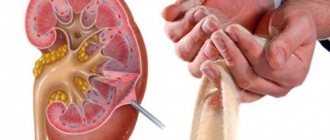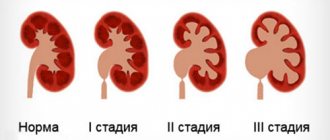Pregnancy is a blessed period in a woman’s life, but at the same time, a huge burden falls on the female body. The kidneys suffer the most, because the total amount of blood in the body increases.
Twice as much plasma passes through the kidneys, renal tissue increases by 30%, and the renal pelvis becomes larger, especially by the 3rd trimester.
The amount of progesterone increasing from the first day of conception relaxes smooth muscles. This is necessary in order to reduce uterine contractions, but the side effect is the relaxation of the muscular sphincter, the valve that regulates the flow of urine, and the softening of the muscle fibers of the ureter. The right ureter suffers the most; 8 out of 10 pregnant women experience dilation of one of the ureters.
Compared to the fact that in the normal state the renal pelvis contains 15 ml of fluid, in a pregnant woman the volume increases to 200 ml. Due to the pressure of the enlarging uterus, urine does not leave the renal pelvis completely and stagnates, which causes infection and inflammatory processes.
For up to 20 weeks, women who had pyelonephritis before pregnancy significantly increase the risk of relapse, and after 20 weeks, kidney inflammation threatens any woman. This is associated with a decrease in immunity and an increase in kidney volume, and the risk of gestational diabetes mellitus. Glucose in urine is a breeding ground for bacteria that cause inflammatory processes.
The bladder also suffers. The hormone progesterone reduces the tone of the muscular walls of the organ; the growing uterus puts pressure on the bladder and deforms it. Urine does not come out completely and stagnates. A decrease in the volume of the bladder provokes a woman's frequent urge to go to the toilet, and if it is not possible to satisfy every urge, urine can be thrown back into the ureter, and from there into the renal pelvis. Reflux is fraught with the transmission of infection, exacerbation of pyelonephritis and more serious pathologies.
Even a healthy woman with a normal pregnancy has a risk of developing kidney and bladder diseases.
Pregnancy and asymptomatic bacteriuria
The content of the article
Inflammatory kidney diseases always have one cause - pathogenic microflora that penetrates from the vagina into the bladder or kidneys. Sometimes this process goes unnoticed, and a woman learns about the problem only in the acute stage. In this case, we should talk about asymptomatic bacteriuria.
Asymptomatic bacteriuria is a disease in which the level of pathogenic bacteria in the urine increases. However, most women do not know about their problem, which is detected only as a result of urine tests. Pathology is judged if the amount of pathogenic microflora exceeds 105 CFU/ml.
Bacteriuria develops in 98% of cases in the early stages of pregnancy and only in 1% in later stages. All cases of bacteriuria must be treated, because this disease is very insidious. It increases the risk of miscarriage and miscarriage by 2-3 times. treatment of bacteriuria in the early stages is effective in 80%, and also significantly reduces the likelihood of prematurity.
One of the common sources of pathogenic bacteria is bacterial vaginosis. Through the urinary tract, microflora enters the bladder, where it actively develops. Bacteriuria is promoted by compression of the bladder and kidneys by the growing uterus. Decreased immunity weakens the body's defenses, so bacteriuria develops in a latent, asymptomatic form. The infection spreads to neighboring organs, kidneys, ureters and even the uterus.
If the placenta becomes infected, the baby's life is threatened. If bacteria enter the kidneys, pyelonephritis develops - inflammation of the kidneys. But in most cases, the disease does not require termination of pregnancy, but in some cases a more dangerous pathology occurs - glomerulonephritis.
How does a kidney cold manifest?
As you know, the inflammation process can affect one kidney, or it can be bilateral. A bacterial or viral infection, severe hypothermia of the body can cause glomerulonephritis, pyelonephritis, pyelitis or nephritis.
In themselves, these kidney diseases are very serious diseases of the genitourinary system of the body, especially when it comes to the fact that a woman has caught a cold in her kidneys during pregnancy.
Along with the general signs of malaise, characteristic pain in the lumbar region is noted. Also, frequent urination is observed, while the amount of urine decreases noticeably. Urination occurs frequently and in small portions.
Signs characteristic of inflammation in the kidneys may also appear:
- painful urination;
- burning sensation and discomfort;
- cloudy urine;
- presence of blood, sand or stones in the urine.
Very often, kidney inflammation is caused by pathogenic microflora (staphylococci, streptococci, etc.) and viruses. Also, the cause of inflammation can be a previous bacterial infection (sore throat, influenza, ARVI).
How does glomerulonephritis affect pregnancy?
Glomerulonephritis is a kidney damage of an immunological and inflammatory nature, in which the glomeruli of the kidneys are affected. The organ cannot perform filtering functions, and renal failure occurs, threatening uremic coma.
The disease does not occur on its own; it is always preceded by an infectious or viral lesion - sore throat, ulcers on the skin, rubella, ARVI. The causative agent of the infection is group A streptococcal bacteria or viruses.
After treatment of a sore throat or other disease and a seemingly complete recovery, the body’s immune system produces antibodies that react with streptococcal antigens.
As a result, immune complexes are formed that circulate through the bloodstream. Then they enter the kidneys for filtration, but the renal glomeruli are not able to pass such large formations. They settle on the glomeruli, significantly reducing the filtering capacity of the organ. Urine formation does not occur, toxic nitrogenous compounds accumulate, which causes severe poisoning of the body. Acute glomerulonephritis is dangerous due to kidney failure and coma in the patient.
The chronic form of glomerulonephritis in pregnant women is rare, no more than 0.2% of cases, because when the body is intoxicated, not only the kidneys, but even the brain and other systems are affected. With glomerulonephritis, ovulation is disrupted, menstruation often disappears, making it very difficult for a woman to get pregnant.
If a woman, when visiting a antenatal clinic, finds out about her pregnancy and at the same time she has glomerulonephritis, she is sent for a full examination to determine the risks for herself and the fetus. Even in a favorable situation (the disease does not cause kidney failure), the disease has the following consequences:
- in 20% of cases complications occur in the form of chronic glomerulonephritis;
- in the acute form, the risk of fetal death and spontaneous miscarriage increases up to 50%;
- the birth of a baby with various defects;
- lethal outcome for the mother if hypertension is added to the disease;
- placental abruption and the risk of having a child with cerebral palsy;
- development of severe anemia.
There are three forms of the disease. Pregnancy is maintained in the first degree of risk, in which the woman does not have major problems with blood pressure and there is no risk of kidney failure.
Diagnosis of glomerulonephritis in a pregnant woman
A peculiarity of the course of glomerulonephritis in pregnant women is the hidden nature of the disease. There have been no specific complaints for a long time, and the patient attributes her malaise to her interesting situation. Mostly pregnant women complain of the following:
- swelling of the face, especially in the morning;
- pain in the lumbar region;
- headache and weakness;
- weak urination up to the absence of urine;
- significant increase in blood pressure;
- increase in body temperature.
It is difficult for a pregnant woman to adequately assess her physical condition, so the only way to detect pathological changes in the body is urine analysis under a microscope. A distinctive feature of the disease is an increase in the overall density of urine due to the high content of various cells, as well as a decrease in transparency and protein loss.
The most telling symptom is hematuria – blood in the urine. If the disease is not in an acute stage, the urine does not change its color. Normally, the number of red blood cells in the urine should be no more than 3-4 units per 1 ml. A significant increase indicates an inflammatory process.
Also, if glomerulonephritis is suspected, the following diagnostic measures are carried out:
DIAGNOSIS OF PYELONEPHRITIS IN PREGNANT WOMEN:
During pregnancy, X-ray diagnostic methods are not used, so clinical observation, laboratory, ultrasound and endoscopic studies are used.
Ureteral catheterization is sometimes used, both for diagnostic purposes and to restore the outflow of urine from the upper urinary tract.
! Urine tests are characterized by the following changes: moderate proteinuria (less than 1 g/l), leukocyturia (the presence of an increased content of leukocytes in the urine), microhematuria (red blood cells in the urine). The most preferable is a urine test according to Nechiporenko, which determines the number of leukocytes and erythrocytes and urine culture, which determines the causative agent of the infection and its sensitivity to antibiotics.
! In the blood: an increase in leukocytes, a neutrophil shift in the leukocyte formula to the left due to an increase in band forms and hypochromic anemia, a possible increase in serum urea levels.
Test for antistreptolysin O (ASL-O)
It allows you to distinguish glomerulonephritis from other kidney diseases, in particular acute pyelonephritis. Once in the body, streptococci secrete the enzyme streptosilin. The immune system secretes antibodies to it, which, when interacting with the enzyme, form proteins.
The analysis makes it possible to determine not only the fact of infection itself, but also the duration of the infection in the body. The normal ASL-O level is 200 units, and any increase indicates a streptococcal infection.
Rehberg's test
It determines the functioning of the renal glomeruli. It consists of two tests: a blood test for creatinine and the same urine test. Blood is donated on an empty stomach in the morning, and urine is collected throughout the day. The last sampling is done 24 hours after the first urination.
Then the contents of the collection container are mixed and 50 ml of urine is poured into a container marked with the patient’s name, age, and weight. The container is immediately sent to the laboratory. Thanks to a daily test, creatinine clearance is determined.
It is calculated using a special Cockcroft-Gault formula. The norm for patients under 30 years of age is 60-125 ml/min. In pregnant women, creatinine is normally slightly lower, so the lower threshold will be 40 ml/min.
Creatinine is excreted from the body only through the kidneys. It is needed for the metabolism of muscle tissue, because without it muscle contraction does not occur. Creatinine is then excreted from the body because it is quite toxic. If there is a lot of creatinine, but little in the urine, this indicates poor filtration of the kidneys.
Kakovsky-Addis test
Aimed at identifying the ratio of red blood cells, white blood cells and urinary cylinders in the urine. A urine sample is obtained in the same way as with the Rehberg test. The object of study is not the urine itself, but the sediment, or more precisely, the composition of the sediment. Red blood cells are normally found in urine in single quantities. In a healthy person, red blood cells are reabsorbed as blood passes through the glomeruli.
If the latter are damaged, then the red blood cells are not filtered out, but end up in the urine. Their number exceeds the norm by 10-15 times. However, an increase in red blood cells is characteristic not only of glomerulonephritis, but also of damage to the urethra, ureter, and bladder.
The level of leukocytes is also pathologically elevated. White blood cells are always present in small quantities in the urine because the immune system is constantly on alert. A significant excess of the norm of leukocytes is characteristic of inflammatory processes of the urinary system. The urinary casts are composed of cells in the inner muscular layer of the renal tubules. They fall out in urine sediment during injuries, in particular glomerulonephritis.
The cylinders vary in composition, and depending on it, one can judge the nature of the disease. In a pregnant woman, hyaline casts are detected with glomerulonephritis or chronic pyelonephritis. In the 3rd trimester, it indicates a violation of the filtration of toxins by the kidneys. Granular casts are characteristic of degenerative changes in the renal tubules and damage to the renal glomeruli.
Waxy casts are formed when urine stagnates in the kidneys, and pathological ones generally indicate serious problems with the kidneys. Erythrocyte casts are formed in chronic glomerulonephritis, and leukocyte casts are formed in chronic pyelonephritis.
In pregnant women, pigment casts are detected in cases of poor unbalanced nutrition against the background of developing anemia. Determining the exact composition of the casts is extremely important because there are false casts that do not indicate any disease.
How does a kidney cold manifest?
As you know, the inflammation process can affect one kidney, or it can be bilateral. A bacterial or viral infection, severe hypothermia of the body can cause glomerulonephritis, pyelonephritis, pyelitis or nephritis.
In themselves, these kidney diseases are very serious diseases of the genitourinary system of the body, especially when it comes to the fact that a woman has caught a cold in her kidneys during pregnancy.
In acute pyelonephritis (when the inflammatory process affects the kidney parenchyma (organ tissue), renal pelvis and calyces), there is a sharp increase in temperature to high numbers - 39-40 C, headache, chills, profuse sweating, severe pain in the lower back, sometimes nausea and vomit.
In this case, weakness and malaise are observed. Blood and sand appear in the urine. Acute pyelonephritis can occur after acute inflammatory conditions (tonsillitis) or against the background of chronic ones (tonsillitis, adnexitis, endometritis).
If acute pyelonephritis is not treated, it becomes chronic, aggravated by hypothermia, colds, and various physiological conditions accompanied by a decrease in the body's resistance (pregnancy).
Glomerulonephritis is characterized by damage to the renal glomeruli. This happens with pneumonia, bronchitis or upper respiratory tract infections. Hypothermia can also cause glomerulonephritis.
A characteristic feature of glomerulonephritis is a combination of the following symptoms:
- pale skin;
- increased blood pressure (BP);
- signs of heart failure (shortness of breath, heart pain);
- blood and protein in urine.
The condition of the body is especially aggravated during pregnancy, when the body experiences enormous stress on the heart, kidneys, and lungs. The appearance of protein in the urine and an increase in blood pressure should alert you, since impaired renal function in combination with hypertension can cause serious complications that pose a threat to the life of the pregnant woman and the fetus.
Kidney ultrasound
For glomerulonephritis, ultrasound is not the definitive diagnostic method, because it reveals only significant structural changes in the kidneys. At the initial stage of glomerulonephritis and in the chronic form of the disease, this method is not informative. Characteristic ultrasound signs of glomerulonephritis are:
- unclear contours of the kidneys;
- increased thickness of the parenchyma;
- increased echogenicity;
- integrated vascular pattern with Doppler mapping;
- excess fluid in the kidneys;
- diffuse changes in kidney tissue.
ECG
Prognosis for the development of pregnancy with glomerulonephritis largely depends on whether the pregnant woman has problems with blood pressure. The most severe complications occur in patients with arterial hypertension, which, in combination with kidney pathology, not only lead to miscarriage, but can also cause death in the expectant mother.
In 35% of women, severe gestosis was observed, in 27% there was nephropathy (damage to the glomeruli of the kidneys), in 8% preeclampsia was diagnosed (a severe complex disorder that threatens to disrupt the functioning of the central nervous system), in 2% there was abruption of the placenta in its normal location. In 35% there is a delay in fetal development and the birth of a premature baby. It is the ECG that allows us to identify changes in the functioning of the heart caused by the consequences of gestosis.
Treatment of glomerulonephritis during pregnancy has an extremely negative effect on the development of the fetus. If the disease is diagnosed in an acute form, the woman is offered an abortion, because pregnancy is impossible.
If you find an error, please select a piece of text and press Ctrl+Enter
How does chronic kidney disease affect pregnancy?
In chronic kidney disease, the course and outcome of pregnancy largely depend on the development and degree of arterial hypertension and renal failure. If blood pressure is normal and under control, and kidney function is good, the pregnancy should end well.
unpleasant consequences
What unpleasant consequences can be expected when a woman with chronic kidney disease becomes pregnant:
- In severe chronic renal failure, pregnancy is more difficult to diagnose because even non-pregnant women have elevated β-chorionic gonadotropin levels. In this case, ultrasound examination will help;
- If high blood pressure is detected, the fetus is at risk;
- If a pregnant woman has a serum creatinine level greater than 124 µmol/l, the number of premature births is 6 times greater;
- Preeclampsia is much more common in patients with chronic kidney disease. In addition, it is more difficult to make a diagnosis because there is already proteinuria and hypertension due to kidney disease.
Preeclampsia should be suspected if proteinuria doubles and blood pressure rises.








